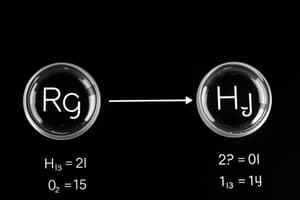Podcast
Questions and Answers
What is the result of an exothermic process on the system and its surroundings?
What is the result of an exothermic process on the system and its surroundings?
- The system and the surroundings remain at the same temperature.
- The system gets warmer, and the surroundings get colder.
- The system gets colder, and the surroundings get warmer. (correct)
- The system and the surroundings both get warmer.
What does the energy value represent in an exothermic process?
What does the energy value represent in an exothermic process?
- The energy released from the system. (correct)
- The energy required to initiate the reaction.
- The energy stored in the bonds between atoms.
- The energy gained by the system.
What is the purpose of a reaction profile diagram?
What is the purpose of a reaction profile diagram?
- To determine the endothermicity or exothermicity of a reaction. (correct)
- To determine the rate of a reaction.
- To determine the equilibrium constant of a reaction.
- To determine the catalyst used in a reaction.
What is the minimum amount of energy required by reactant molecules to initiate a reaction?
What is the minimum amount of energy required by reactant molecules to initiate a reaction?
What is the difference between an exothermic and an endothermic process?
What is the difference between an exothermic and an endothermic process?
What is a limitation of reaction profile diagrams?
What is a limitation of reaction profile diagrams?
Which term describes chemical reactions in which products can decompose to form back the reactants?
Which term describes chemical reactions in which products can decompose to form back the reactants?
At equilibrium in a reversible reaction, the forward and reverse reactions occur at what rate?
At equilibrium in a reversible reaction, the forward and reverse reactions occur at what rate?
What does a double-sided arrow in a chemical reaction indicate?
What does a double-sided arrow in a chemical reaction indicate?
What is the equilibrium constant specific to concentration labeled as?
What is the equilibrium constant specific to concentration labeled as?
In a reversible reaction involving N2O4 and NO2, what does the equilibrium constant express?
In a reversible reaction involving N2O4 and NO2, what does the equilibrium constant express?
At what point in a reversible reaction do both the forward and reverse reactions occur at equal rates?
At what point in a reversible reaction do both the forward and reverse reactions occur at equal rates?
What is indicated by the apex of the curve in a reaction profile diagram?
What is indicated by the apex of the curve in a reaction profile diagram?
In a reaction profile diagram, what can be inferred about the energy of the product molecules compared to the reactant molecules in an exothermic reaction?
In a reaction profile diagram, what can be inferred about the energy of the product molecules compared to the reactant molecules in an exothermic reaction?
What is the duration of the activated complex or transition state?
What is the duration of the activated complex or transition state?
What is the purpose of studying thermodynamics in chemistry?
What is the purpose of studying thermodynamics in chemistry?
What is the significance of the transition state or activated complex in reactions with elementary steps?
What is the significance of the transition state or activated complex in reactions with elementary steps?
What is the importance of knowing the spontaneity of a reaction in industrial production of chemicals?
What is the importance of knowing the spontaneity of a reaction in industrial production of chemicals?
Flashcards are hidden until you start studying
Study Notes
Exothermic Processes
- Exothermic processes release energy to the surroundings, increasing their temperature.
- In exothermic reactions, the energy value represents the amount of heat released as products form from reactants.
Reaction Profile Diagrams
- Reaction profile diagrams illustrate the energy changes during a reaction, showing the transition states and energy barriers.
- They help visualize the difference in energy between reactants, products, and the activation energy required.
- A limitation of reaction profile diagrams is that they do not provide information about the speed of the reaction.
Activation Energy
- The minimum amount of energy needed for reactant molecules to initiate a reaction is known as activation energy.
Exothermic vs Endothermic Processes
- Exothermic processes release heat, while endothermic processes absorb heat.
- In exothermic reactions, product molecules have lower energy than reactant molecules, while endothermic reactions have higher energy products.
Reversible Reactions
- Reactions where products can decompose back into reactants are termed reversible reactions.
- At equilibrium in a reversible reaction, the forward and reverse reactions occur at equal rates, resulting in constant concentrations of reactants and products.
- A double-sided arrow in a chemical reaction indicates reversibility.
Equilibrium Constant
- The equilibrium constant specific to concentration is labeled as Kc.
- In a reversible reaction involving N2O4 and NO2, the equilibrium constant expresses the ratio of concentrations of products to reactants at equilibrium.
Transition State
- The apex of the curve in a reaction profile diagram indicates the peak energy level of the activated complex or transition state.
- The activated complex has a very short duration, representing a high-energy state before the reaction proceeds either way.
Thermodynamics in Chemistry
- Studying thermodynamics is crucial in chemistry to understand energy changes, predict reaction spontaneity, and optimize reaction conditions in industrial chemical production.
- Knowing the spontaneity of a reaction helps in effective planning and scaling up of chemical processes.
Studying That Suits You
Use AI to generate personalized quizzes and flashcards to suit your learning preferences.




